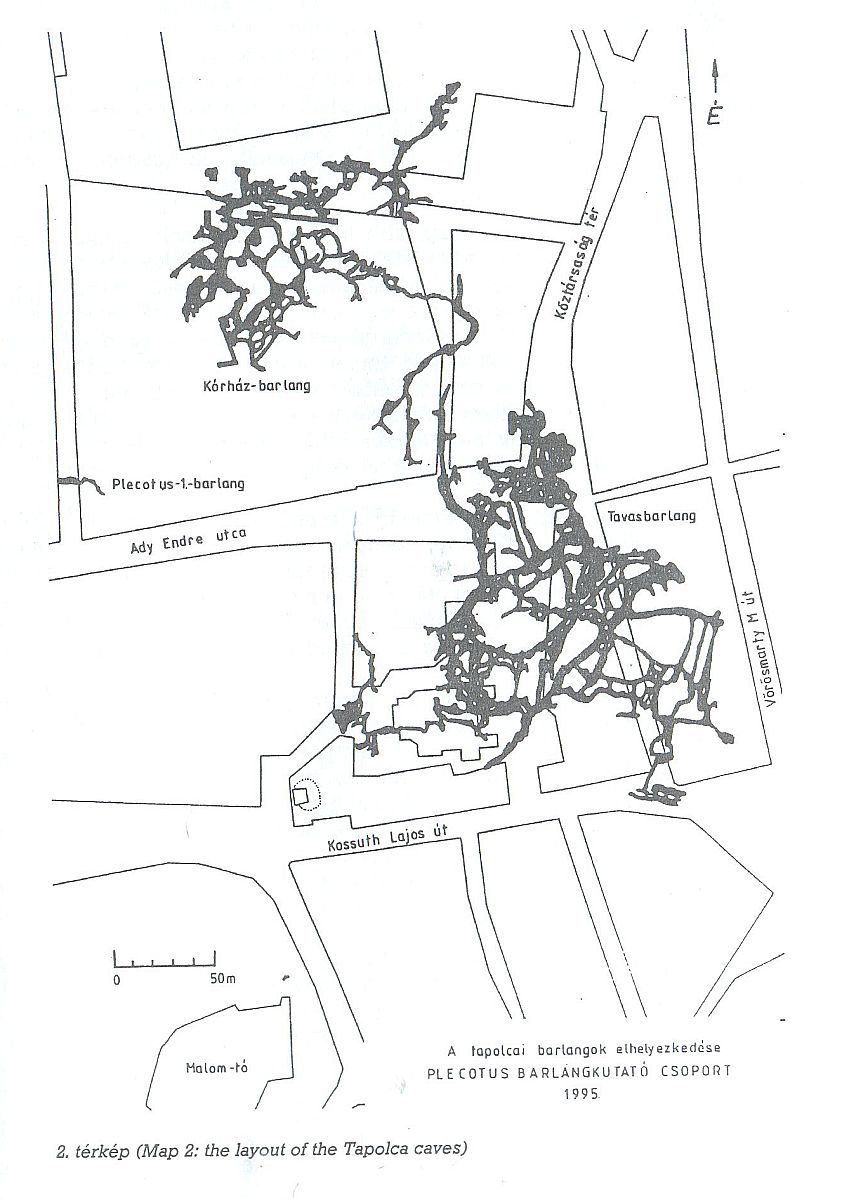KOLLÁTH János
PLECOTUS Barlangkutató Csoport - Magyarország
PLECOTUS Caving Group - Hungary
A tapolcai barlangok bemutatása
An Introduction of the Tapolca Caves
Tapolca városa alatt két nagyméretű barlang található. a Tavasbarlang és Kórház-barlang, összesen mintegy 6.500 m járathosszal. Itt jött létre a Dunántúl legnagyobb víz alatti terme (21 m átmérő. 19 m magasság). Összefüggésüket több módszerrel is sikerült már kimutatni, de járható kapcsolatuk megteremtése még várat magára.
A barlangok jelentőségét mind idegenforgalmi, mind gyógyászati szempontból ki kell emelni. A Tavasbarlang jól látogatott turista-látványosság. A Kórház-barlangban 1972-től folyik légzésterápiás gyógyítás.
Visitors, to the center of the Tapolca basin of our city don't have any idea about the underground world below the urban area. Due to continuous exploration. an important natural asset has become nationally well known.
Below the city, there are two big caves (Lake Cave and Hospital Cave) with a total length of more than 6,500 m. Even though the connection has been proven by several methods, the caves are not yet connected.
The closest distance between these caves is these than 10 m. There are two other caves (Kincsesgödör, Plecotus 1-Cave) that may prove 10 be of considerable size by extended exploration. Plecotus-l Cave is supposed to be connected to Hospital Cave. New cavities are very probable on the 5 km:! limestone plateau. We have information about another 12 indications and blocked cavities, of which the biggest is 80 m long.
The area is built up of Sarmatian (13 million years old) limestone, which was deposited in brackish water. Its content of insoluble materials is high. its stability is low, and it is well bedded. It is rich in mollusk and bivalve fossils. Cave-ins are frequent in the cave passages. and cave fill is massive.
The cave forming agent is mixing corrosion. The springs discharging the karst system of the Bakony
Mountains meet with ascending waters. A curiosity is that the system is still active, and part of the passages is filled by 19•21°C water which discharges in the Malom Lake. The center of the uprising thermal waters is supposed 10 be north from the Hospital Cave. The biggest cave hall of Transdanubia is known from here (21m in diameter, 19m height).
Passages are found 8-12m below the surface in 4 levels. Labyrinth-like creeping passages are frequent. Bigger passages follow NE•SW and NW-SE fractures. Between the surface and the passages, there is a 3 m thick calcareous marl layer. This is an aquiclude which impedes surface infiltration, therefore dripstones are scant and can be observed only at the fractures.
Speleothems are rare. Millimeter size calcite crusts may occur on the walls, and occasionally on the infilling sediments of the bottom. Aragonite needles may also occur in places where the direction or the speed of the air flow in the cave changes suddenly. According 10 our present knowledge, they form from aerosol. Calcareous thin roots may also occur which form nest-Like structures.
Caves are important from both a tourist and health point of view. The Lake Cave is one of the most frequently visited caves of Hungary, where it is also possible to row a beat. Respiratory therapy has been earned out in the Hospital Cave since 1972. Proper threatening on the surface is also provided. The cave is accessible by an elevator from hospital grounds.
There is a potential 10 further utilize the Tapolca caves. The exploration of new, big passages could be targets of additional show eaves or health activities.
Considering the extension and rate of karstfication of the area, we can say that this is an important karst region of the country. Based on calculations, the total length of the passages that can be explored should be as much as 15 km, together with the already known passages.

